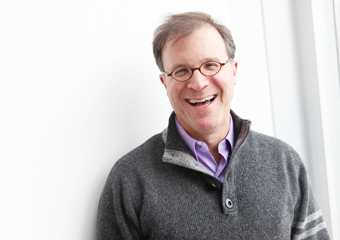Hebrew Roots
Permanent link All Posts

Author Ilan Stavans at Spertus Institute of Jewish Studies
Photo Credit: Jeremy Lawson
Growing up in a Yiddish-speaking community in Mexico City, Ilan Stavans experienced a variety of linguistic conundrums. As a child, each language was assigned a role – Spanish for public life, Yiddish for private, Hebrew for religious – those distinctions left an indelible mark on the author, linguist and lexicographer Stavans would become.
Today, he believes language is fluid and flexible, able to adapt to any situation.
“I don’t believe that language is at any point static or stable. Only a dead language does not change,” says Stavans, a professor of Latin American and Latino Studies at Amherst College in Massachusetts and the author of several novels, collections of short stories and academic treatises. “A living language lends and borrows. The health of a language can be registered in its contact with other languages.”
Stavans personal journey to find the life of his dormant Hebrew, which he learned as a teenager and spoke during a year’s sojourn in Israel, is chronicled in his latest book,
Resurrecting Hebrew
, which is part of the “Jewish Encounters” series from Schocken Books. More than simply a linguistic memoir, the book also attempts to map the path of Hebrew from the sacred language of the Torah to the modern tongue spoken by millions. Stavans spoke about this book and other linguistic journeys at a recent Nextbook presentation at Spertus Institute.
It all starts with a dream. In it, Stavans meets a woman who speaks a foreign – yet familiar – language to him. Once Stavans figures out that the mysterious language is Hebrew, he realizes that he had what a friend would later call “language withdrawal.” The same friend also introduces Stavans to Eliezer Ben Yehuda’s autobiography, written in Hebrew, of course.
We might remember from Sunday school lessons that Ben Yehuda can be credited with revitalizing Hebrew and bringing it from the realm of the sacred to the everyday. Ben Yehuda saw Hebrew as the antithesis to Yiddish, which stood for everything early Zionists did not want to embrace: assimilation and persecution, Stavans says.
Yet today’s Hebrew is far different from the language Ben Yehuda helped to revive. As Stavans points out, if Ben Yehuda heard Hebrew spoken today, “he would be totally shocked.” Today’s Hebrew is influenced by the communities of its speakers: native-born Israelis (sabras), Mizrahi Jews, Russian Jews, Sephardic Jews, Ashkenazi Jews. And Arabic and English have infused both slang and everyday terms into Hebrew.
“Ben Yehuda wanted to go back to the original sacred language and expand it to the needs of today,” Stavans says. “But the purity [of language] that he celebrated he wouldn’t find today.”
This very mixture of linguistic traditions – one that Ben Yehuda would have abhorred – fascinates Stavans. Before resurrecting his own relationship to Hebrew, Stavans spent years studying Spanglish, the hybrid of English and Spanish spoken largely by immigrants from Latin America. While English is the language of public communication, many Latinos retain Spanish for private interaction among family and friends. Still, English makes inroads into that sphere with new concepts introduced into the more traditional Spanish.
Stavans’ interest in Spanglish is the direct outgrowth of his Yiddish upbringing. The 1960s Bundist – socialist Zionist – community of Stavans’ childhood saw Yiddish as “the ticket to identity.” Yet Yiddish itself is a hybrid language, mixing traces of Biblical Hebrew with vernacular German. And as Yiddish teachers died or retired, Israeli schlichim (Jewish Agency emissaries) replaced them, bringing with them a new dimension to an already convoluted language identity, Stavans says.
The boundaries between languages became fainter as Yiddish began to disappear, too. The juxtaposition of being a Mexican and a Jew became symbolic of the past, only to be replaced by the feeling that the community was not doing enough Jewishly, Stavans says. After all, the ultimate goal of learning this new language – Hebrew – was aliya. “Resurrecting Hebrew” dwells on the relationship between Israel and Jews outside it as much as it recalls the history of the actual language.
“Hebrew is the DNA carrier of who Jews are,” Stavans says. “It is a language carrying secrets that enable our people to survive.”
And yet, for all we know, this moment in Hebrew’s history is only the cradle of a new, powerful tradition, Stavans says. And who knows might happen in the next millennia?
The next Nextbook at Spertus event will feature Ariel Sabar, author of My Father’s Paradise Sunday, Jan. 25 at 2 p.m. A book signing will follow the talk.



.jpg)



